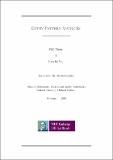| dc.contributor.author | Ha Van, Hieu | |
| dc.date.accessioned | 2019-03-29T16:28:22Z | |
| dc.date.available | 2019-03-29T16:28:22Z | |
| dc.date.issued | 2019-03-29 | |
| dc.identifier.uri | http://hdl.handle.net/10379/15081 | |
| dc.description.abstract | An entry pattern matrix (EPM for short) is a rectangular matrix in which each entry is an indeterminate. The same indeterminate may appear in multiple positions, but different indeterminates are independent. For a field F, an F-completion of an EPM is the matrix that results from assigning a specific value from F to each indeterminate that appears as an entry of the matrix. In this thesis, we are concerned with the set of F-completions of an entry pattern matrix which can be considered as a vector space whose dimension is equal to the number of distinct indeterminates appearing in the entry pattern matrix.
Chapter 1 presents some background to the content of Chapters 3, 4, and 5. We discuss linear subspaces of square matrices in which every non-zero element is either nonsingular, and in which every element is nilpotent. In particular, we consider bounds on the dimensions of such spaces.
In Chapter 2 we will introduce the concept of an entry pattern matrix and discuss some general properties.
In Chapter 3 we will consider the maximum rank of a completion of a given entry pattern matrix over a field F. We will show that this number can depend on the field under consideration, and focus on cases where it does. We will define the generic rank and the maximal completion rank of an entry pattern matrix and introduce the concept "EPM-rank-tight" field and prove that every finite field of characteristic less than 17, except F_2, is EPM-rank-tight.
In Chapter 4 we will introduce the concept of an F-almost-nonsingular EPM as an EPM whose completions are all nonsingular provided that their entries are not all equal. We present constructions for entry pattern matrices that are almost-nonsingular over the real, the rational fields and over finite fields, and obtain lower bounds for their numbers of indeterminates
In Chapter 5 we will give bounds for the number of indeterminates in n*n nilpotent entry pattern matrices over fields of positive characteristic. We also give the classification of such entry pattern matrices attaining the bounds. | en_IE |
| dc.publisher | NUI Galway | |
| dc.rights | Attribution-NonCommercial-NoDerivs 3.0 Ireland | |
| dc.rights.uri | https://creativecommons.org/licenses/by-nc-nd/3.0/ie/ | |
| dc.subject | Entry pattern matrices | en_IE |
| dc.subject | vector spaces | en_IE |
| dc.subject | nonsingular | en_IE |
| dc.subject | nilpotent | en_IE |
| dc.subject | maximal dimension | en_IE |
| dc.subject | almost-nonsingular | en_IE |
| dc.subject | pseudo-EPM | en_IE |
| dc.subject | Mathematics, Statistics and Applied Mathematics | en_IE |
| dc.subject | Science | en_IE |
| dc.title | Entry pattern matrices | en_IE |
| dc.type | Thesis | en |
| dc.contributor.funder | College of Science, National University of Ireland, Galway | en_IE |
| dc.contributor.funder | Vietnam National University, HCMC | en_IE |
| dc.local.note | This thesis may be interpreted within the context of matrix completion problems, which are broadly concerned with the identification of properties that a matrix may or may not possess, based on partial knowledge of its entries. | en_IE |
| dc.local.final | Yes | en_IE |
| nui.item.downloads | 187 | |


